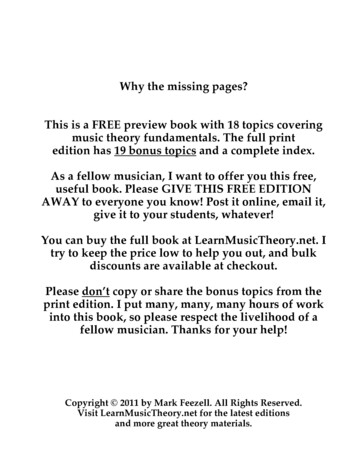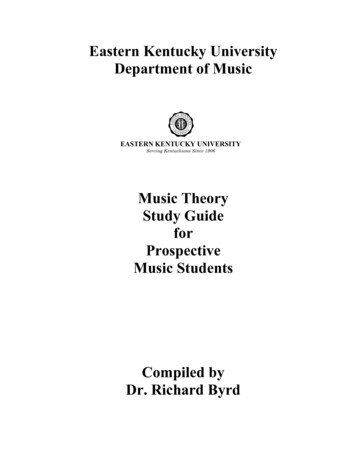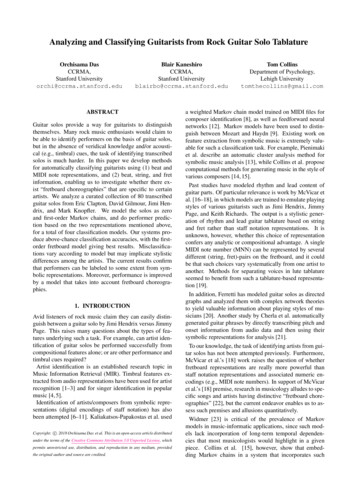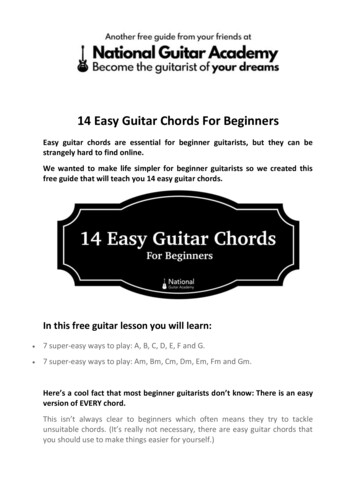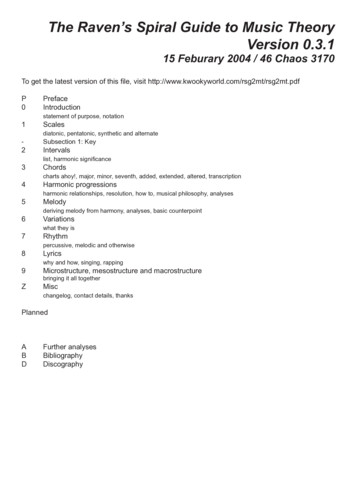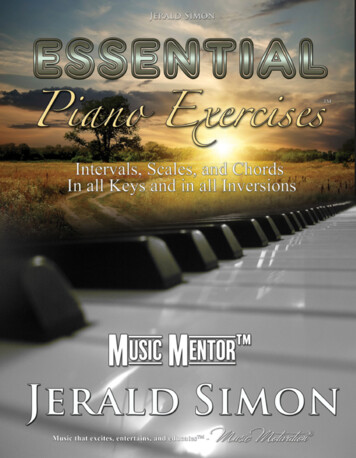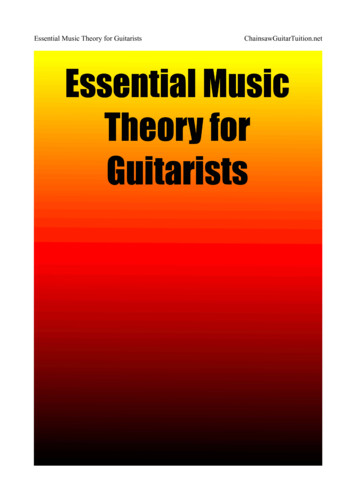
Transcription
Essential Music Theory for uition.net
Essential Music Theory for GuitaristsChainsawGuitarTuition.netTable of ContentsWhat is "Music Theory"?.3The Musical See-Saw.3The Music Theory.3How does it help?.4How to read Guitar Tab.5Guitar Tab for Beginners.5How to Read Guitar Tab.5Common Mistakes.6Picking Direction.6Slides.6Stringbends.7Vibrato.7Tremolo Picking.7Legato.8Muting.8The Major Scale.9Harmonising the Major Scale.9How to make a Chord.9Using the Major Scale.10Harmonising a Scale.10The Major Scale.11Thinking Harmonically.11Moving up the Scale.12Roman Numerals.13WHY?!.13The Notes of Chords.14The Notes of a Piano.14The Major Chord.15Minor Chords.16.and for Guitar?.16Understanding Key Signatures.17How a Key Signature works.17Sharps and Flats.19Chord Inversions.20What are Inversions?.20Inverting Chords.20Examples.20Using Inversions.22The Guitar Chord Key Transposer.23Writing your own Songs.24Roman Numerals.24The I - IV - V progression.24The ii - V - I.25The iv - V - I.25Creating your own Chord Progressions.25ChainsawGuitarTuition.net
Essential Music Theory for GuitaristsChainsawGuitarTuition.netWhat is "Music Theory"?When people hear the word "theory", they automatically assume its like something you would learnin a class at school. Its true that music is taught this way sometimes, but that's not the whole story!So, to start with what is "music theory"?The Musical See-SawJust because something is "theory", doesn't mean it has to be boring and taught by aging professorswith grey hair and glasses! The "theory" of something is just the explanation of how and why itworks, right? Imagine you had a see-saw, you sit on one end, and your friend sits on the other. Now,if you jump up, pulling the see-saw with you, your friend will go downwards. When your friendgets to the ground they'll jump up and you'll come down.I'm sure you're familiar with the situation! What I've just described is the "practical" side of things. Icould also describe it to you as "see-saw theory". For example: the see-saw is balanced over a pointdirectly in the middle of both of you. When you jump up, you're taking your weight off of the endyou're sitting on. This causes your end to rise, and the other to fall across the pivot point (i.e. thestand in the middle). When your weight is re-applied, and their weight is removed (they jump up),the reverse happens and you come down.If you've ever used a see-saw before, you would already know all of this. In fact, you're probablyperfectly capable of describing the "see-saw theory" in your own words, and you probably couldhave done as a kid as well. Did knowing how a see-saw works mean you enjoyed it any less? No?Actually, you might have enjoyed it even more (because you knew better how to control it and useit).The Music TheoryWell, guess what? The same thing applies to music theory!No, I'm not talking about physics and weights this time, but sounds instead. Music theory is whatwe use to describe how music works, just like with the see-saw example, and just as with the seesaw, knowing how it works will not spoil how much you enjoy it. Music theory does not destroyyour creativity anymore than understanding how the see-saw works destroys a child's ability to rideit!With music theory, we're more concerned with things like "Which chords go together, and why?",or "Which scales go with which chords?". If you think about it, the only alternative would be: theseare noises, you can make them with a guitar or a bass. Go.If that was how music worked, this would be a very small website indeed!ChainsawGuitarTuition.net
Essential Music Theory for GuitaristsChainsawGuitarTuition.netHow does it help?How does music theory help you? Well, just the same way that knowing how to construct asentence or form words helps you to talk to people. Otherwise you're kinda stuck with randomgrunts. Sure, every now and then you may grunt something intelligible, just like if you didn'tunderstand any music theory you can still compose good music!You don't have to understand everything about music theory, either. Just enough to do what you do,or just as much as you're interested in using. For example, you wouldn't learn Greek if you had noGreek friends or relatives, and you had no interest in the language. What would be the point? Juststick to English (or whichever is your first language). Same goes for music theory, there's no needto learn the modes of the melodic minor if you don't like the sound of the scale and don't play jazz.Just at least learn the pentatonic scale, and maybe the major scale.So, my advice is: don't be afraid of "music theory". It can only help you out!ChainsawGuitarTuition.net
Essential Music Theory for GuitaristsChainsawGuitarTuition.netHow to read Guitar TabTablature, or "tab", is a system of musical notation that focuses on where you place your fingers,rather than the actual musical pitches. You've probably heard of "guitar tab" on the interwebs, but"tab" is not something specific to the guitar (tabs also exist for banjo, harmonica, lute, harp,organ.and even piano), nor is tab a recent invention!Guitar Tab for BeginnersGuitar tab is generally very similar to the above, with vertical lines representing the strings, andnumbers telling us which fret to play on that string. Because tab doesn't show you the pitches, butwhere to put your fingers, the tuning of each string is normally written just before it (reading fromleft to right).Here is an example of some guitar ----5------5-----3------3-0-0---0-0----As you can see, there are six vertical lines, each one represents a guitar string. They are labelledaccording to their tuning (with the capital "E" being the thickest string, and the small "e" being thethinnest). If you're unsure about standard guitar tuning, please refer to my post on how to tune yourguitar.How to Read Guitar TabEach number represents a fret (which are numbered from the head of the guitar up to the body), andthe line that the number is on tells you which string to play. For example, in the above guitar tab thefirst note you play is the open low (thickest) E string (reading from left to right), twice. You can tellit's the thickest string because it's on the lowest line, and you can tell that it's an open string (i.e. nofingers on it) because it's an "0".Next, the tab is telling you to play the 3rd fret on the A string, and the 5th fret on the D stringtogether (together because they are stacked).ChainsawGuitarTuition.net
Essential Music Theory for GuitaristsChainsawGuitarTuition.netCommon MistakesRemember that you read the tab from left to right, and ALL strings at the same time. So if you havesomething like --.you would start by playing the open "high e" (thinnest string) and the third fret on the "low E"(thickest string) at the same time.Also, notice that the lowest line in the tab represents the thickest string on the guitar. This may seembackwards at first, and you should be wary of playing the whole tab upside-down! Just rememberthat it's as if the tab was the right way up on your lap. The nearest string to you on the tab (thebottom one) would be the nearest string when you hold the guitar (the thickest one).Guitar Prothe program that I recommend for reading and writing guitar (and bass) tab is Guitar Pro. If youwant something better than the text based tab I've used in this post, then you really must have adedicated program to display it.Now, we're going to go a little more in-depth and look at some of the other symbols you'll find on atab (most of these symbols refer to the tabs you'll find on the Internet).Picking DirectionThe direction you pick is usually represented by the letter "D" for down (towards the ground), and"U" for up (towards the sky), but is often left off altogether.SlidesChainsawGuitarTuition.net
Essential Music Theory for GuitaristsChainsawGuitarTuition.netSlides are normally written either with "/" (for a slide up in pitch) and "\" (for a slide down). Forexample:e --------------------B --------------------G -----5--------------D -5/7---7\5----------A --------------------E --------------------Here, you would play the 5th fret on the D string, slide up to the 7th fret then play the 5th fret on theG string. Next, pick the 7th fret on the D string and slide the note down to the 5th fret (only pickingthe string once for each slide!).StringbendsThese are when you bend a note up or down to change it's pitch. Usually notated with "b". So, forexample "5b(7)" would mean you play the 5th fret, and then bend the string so that it sounds thesame as the pitch of the 7th fret. The 7 is in brackets because you don't re-pick the note.Other variations include:(7)b5 which would be the reverse of the above example. Bend the 5th fret up to the pitch of the 7thBEFORE playing it, then pick it and return it to it's normal pitch. Sometimes also written as "pb"for "pre-bend", "r" for "release" (as in "(7)r5"), or "bd" for "bend down".5b(7)--(7) which means you need to play the 5th fret, bend it up to the 7th fret, hold it, then re-pickthe 7th fret. Sometimes this is written with "rp" for "re-pick".You may also see "5b1/4" which means to bend the pitch up by half a fret (used a lot in blues)creating a quarter-tone bend (as each fret is a semitone).VibratoVibrato is when you "wobble" the note, usually by bending it up and down continuously by a smallamount (not usually as much as a whole fret). Usually notated in tab by " ", it comes it three mainforms: standard (just " " over a note); "wide", and with the whammy bar (written with " " and"w/bar").Tremolo PickingSomething that confuses a lot of people is that "Tremolo" is not technically a technique in itself, buta musical effect- the effect of playing one note multiple times, very rapidly, for a "shimmering"ChainsawGuitarTuition.net
Essential Music Theory for GuitaristsChainsawGuitarTuition.neteffect. In electric guitar circles, you'll hear it referred to as "tremolo picking" because the notes areusually alternate picked (down and up picking), but tremolo can be done on any instrument.Notes that are tremolo picked would be notated with "tp" above (for "tremolo picking").LegatoLegato, or hammer-on's and pull-off's, is written with either "h" for "hammer", "p" for "pull off" or"T" for right hand tapping. For ay just look like a bit of a mess, but let's decode it! Here you play the 5th fret on the D string thenhammer a finger from your right hand onto the 7th fret (to sound it without picking it).Next, hammer a finger from your picking hand onto the 10th fret on the same string without picking(notated by the "t") and "pull off" back to the 7th fret (notated by the "p").Lastly, you need to pull the finger off of the 7th fret to sound the note on the 5th (which you're stillholding down). I recommend using your first finger for the 5th fret, your third for the 7th, andwhichever you like for the 10th (on the other hand, of course).There is also something called a "trill", notated with "tr". This means you rapidly alternate betweenthe two notes by hammering on and pulling off. For example: 5tr(7) means trill between the 5th and7th frets (the "tr" may also be written above).MutingAny notes that are supposed to sound muted are written with an "x" instead of a number (mutedwith the fretting hand), or with "P.M." written above (short for "palm muting", muted with thepicking hand).That should just about cover the main techniques that you'll find notated in guitar tab.ChainsawGuitarTuition.net
Essential Music Theory for GuitaristsChainsawGuitarTuition.netThe Major ScaleSo we're starting our look at guitar scales with the major scale. Why? Because it's the basis for mostmodern music theory! Sure, it started out life as the "Ionian Mode" (under an ancient Greek systemof music theory), but it has moved on since then and turned into the famous scale that we know an(sometimes) love.If you want to hear what this scale sounds like (in case you didn't know already), just play the whitenotes of a keyboard from "C" to "C", or failing that here is the pattern for the -------------------------------------------Again, the example above is from "C" to "C" and contains the notes: C D E F G A B C. If you wereto play it along one string, it would look like this:A --3--5--7--8--10--12--14--15Here you can see the pattern of intervals (or "distances between the notes") that make up a majorscale. You can start on any note in the world, and (if you follow this pattern) you'll create a majorscale. If we take a closer look at the distances (in frets) we have this:A --3--5--7--8--10--12--14--15---- 2 2 1 2 2 2 1 Remember that pattern! Musically, a distance of two frets is a "tone", and a distance of one fret is a"semi-tone" (half a "tone"). So, you could say that the pattern of intervals in a major scale is: tone,tone, semitone, tone, tone, tone, semitone. Sounds really "theoretical" huh? All it's saying is that tofind the notes of any major scale, follow the pattern of fret distances above.Harmonising the Major ScaleOne of the very special things about the major scale is that when we create chords with it, they're allin a "major key". For example, if you write a song using only the notes in the C major scale above,you're song will be in the "key" of C. In order to do this, both the melody and chords need to bemade out of these notes.How to make a ChordChords are basically made of a 1, 3 and a 5. What does that mean? Well, say we use the scale above:ChainsawGuitarTuition.net
Essential Music Theory for GuitaristsChainsawGuitarTuition.netCDEFGABCNow, those are the only notes we're allowed to use if we want to stay in the key of C. Let's start atthe first note: "C", This becomes "1" in our chord. We also need to find 3 and 5. So, if C is one wecount D as 2 (going along the scale), so E is three. Therefore we have C and E in our chord.Following this pattern, G is 5. So our chord of 1, 3 and 5 becomes C, E and G. These are the notesin a C major chord (and that's how a chord is born).We wont get into the whole process just yet (see the next chapter), but if you follow the patternfrom each note, you'll end up with these chords:C major (C E G), D minor (D F A), E minor (E G B), F major (F A C), G major (G B D), A minor(A C E), B diminished (B D F)Remember: the pattern of notes repeats when you get to C again.Using the Major ScaleAll of the above chords are in the key of C, and the pattern of major, minor and diminished is thesame for every major scale (just the notes all move up or down depending on which key you're in). Imay do a post in the future about harmonising scales (because it's quite an important concept forknowing which key you're in!).This has been quite a long post, but I'll end it by summing up the most interesting points about themajor scale, they are:- It is used to create the Major Key- The major third (distance between first and third notes) gives it a "bright", or "happy" sound- The 5th chord (the G major in the key of C, above), can turn into a dominant 7 chord for astronger, V7 - I cadence (resolution)- It's probably the most important scale you'll learn about (even if you don't choose to use it.)Harmonising a ScaleChainsawGuitarTuition.net
Essential Music Theory for GuitaristsChainsawGuitarTuition.netHave you ever wondered where all these guitar chords come from? Or how to tell if something is ina particular key? Why do certain scales work over certain chords, and not others? I'm going tocreate this post as a reference point (to refer back to in future) where I'll answer all these commonlyasked questions.The Major ScaleLets looks at the C major scale as an example, here are it's notes:CDEFGABNow, there are two ways to think about this scale: melodically (as in, soloing and writing tunes), orharmonically (as in the chords that fit with it). If we look at the scale purely melodically, it makessense to number the notes from 1 to 7:1 2 3 4 5 6 7C D E F G A BNow we can talk about the scale degrees as numbers (for example, you could say: "The third note ofthe C major scale is an E", and I might say "Yes, it's a major third (four frets) above C"). Thedistances in frets (or intervals) are important here too, but we'll get to that later.Thinking HarmonicallyIn order to make chords that fit with this scale, they need to be made from the notes of the scale. So,all our chords are going to be made from some combination of: C's, D's, E's, F's, G's, A's or B's.Lets looks at those scale numbers again:1 2 3 4 5 6 7C D E F G A BDo you know what the definition of a chord is? It's "a combination of three or more notes that blendharmoniously when sounded together" (that definition thanks to my dictionary). So for each chord,we need at least three notes. The very first chord in C major is going to start on the very first note(makes sense, huh?)- so the first note of our first chord is a "C". The first note of any chord is calledthe "root note", and it's what gives the chord it's letter name (although the "first note" doesn't alwaysmean the lowest in pitch, just the note that gives the chord it's name).Next, we need a "5th", which works as a kind of "thickener" to the chord (and doesn't change muchabout the way the chord sounds, but makes it "fuller"). We get this from- you guessed it- the 5thnote up from our root. Count up the scale:1 2 3 4 5ChainsawGuitarTuition.net
Essential Music Theory for GuitaristsChainsawGuitarTuition.netC D E F GThe fifth note up from out root is a "G". So that'll be the next note in our chord.Now we add one of the most important notes: the 3rd. The third will either be a major third, or aminor third and it lives (can you guess?) three notes up the scale from our root note. In this case it'san "E". Importantly, "E" is four frets up from "C", which makes it a strong major /strong thirdin our chord. Here is that distance in guitar tab (on just the A string):A --3------7--Any two notes that are this far apart are a "major third" apart. The chord we have made is a "CMajor" which means it has a "C" root note, and a note that's a major third above that (the fifth isn'tinteresting enough to add to the name!) hence: C MAJOR.Moving up the ScaleThe next chord from this scale starts on the second note, "D". So now we have to re-number thescale with "D" as 1.1 2 3 4 5 6 7D E F G A B CWe use the same process again to find our chord: take a 1, 3 and 5. This time we get the notes: D, Fand A. So the root not is "D" (giving us some kind of "D" chord) and this time the third is three fretsup from the root:A --5------8--This is a minor third (because it's slightly smaller than a major third). So the chord is called "DMinor" (D root note, minor third). If you follow this process up the scale you'll find the chords in aC major scale to be:C major, D minor, E minor, F major, G major, A minor, B diminished (i.e. minor third with a flat 5thinstead of a 5th)The pattern of major and minor chords is the same for every major scale- so if you have a song withthese notes in, it'll be in the "key of C major" or the "key of C". A good place to check is if the songhas two major chords a tone apart (because these'll probably be the 4th and 5th chords of a majorscale). From there you can work out what key something is in.ChainsawGuitarTuition.net
Essential Music Theory for GuitaristsChainsawGuitarTuition.netRoman NumeralsIn music, you'll sometimes see things like: "V7 - I", "ii - V - I" or "I - IV - V". Just what do theymean?!Well, lets look back at how our scales are numbered:1 2 3 4 5 6 7C D E F G A BFor some reason, musicians like to use Roman Numerals instead of the usual Arabic ones torepresent the chords build off each note in the scale, so that gives us:I II III IV V VI VIIC D- -E- F- G A- -B.but that's only half the information! We don't anything about the types of chords we're looking at.That's why we use capital letters for major chords, and small letters for minor chords. This makesour major scale look like this:I ii iii IV V vi vii C D- -E- F- G A- -BCapital numbers are major chords, and small numbers are minor chords. The little " " signifies adiminished chord.WHY?!This system is good because we can talk about chords and chord progressions without actuallyhaving to refer to a particular key. For example, if we talk about a "ii - V - I", in C those chords willbe: Dm, G and C.but we could also apply it to the key of G (Am, D and G) or A (Bm, E and A) orany key we wanted to, because we have all the information there except which key it's in (making itmore useful for talking "in general" about chords or keys).ChainsawGuitarTuition.net
Essential Music Theory for GuitaristsChainsawGuitarTuition.netThe Notes of ChordsSo, which notes are in which chords, again?Now, I have written about this one before, but sometimes its good to look at things from a slightlydifferent angle. You see, last time we looked at harmony and chords we took it from a guitarfretboard perspective. This is sometimes great when it relates directly to getting the right soundsfrom a guitar.but, the layout of a guitar fretboard can seem pretty random if you're not used to it! Check out thewebsite for a diagram of the notes of the fretboard and you'll see what I mean. Sure, there arepatterns there, but this isn't the most straightforward way to see it when trying to grasp the theory!So.which instrument is laid out in a more straightforward way?The Notes of a PianoYup. I wouldn't normally suggest looking at another (seemingly unrelated) instrument whenlearning guitar, but the piano- or any keyboard instrument- literally has the notes in a line fromlowest to highest. On a piano there are no duplicate notes, no sideways "string skipping" oranything like that. The notes are just ordered from lowest to highest. Simple.So, here is our keyboard:The key with a little square on it is known as "middle C". This is the note that is roughly in themiddle of the keyboard and is a "C" note (I told you this was more straightforward!). Take note ofit's position- there are two black notes directly to the right of it. This is true of every "C" on thekeyboard.Each of the white keys on a keyboard has a different note letter (the black keys are sharps and flats,more on those later). For example, here is our octave of notes:ChainsawGuitarTuition.net
Essential Music Theory for GuitaristsChainsawGuitarTuition.netThis also happens to be a C major scale on the piano, which is a very useful coincidence becausenow we can look at harmonising this scale into chords using just the white keys of the piano!The Major ChordIf you've already read about how to create chords, you'll know that you need: a root note (whichgives the chord it's letter name), a third (which tells us if the chord is major or minor), and a 5th(which just kinda acts as a "thickener" note).You should also be aware that these notes are found by counting up from the root note. Forexample, if you want to find the notes of a "C major" chord, you can count up with "C" as one, "D"as two.etc.On a keyboard this becomes even easier to see than on guitar. Here is a C major chord on akeyboard (in red):Because the notes on a keyboard are arranged in order of pitch, you're literally just playing onenote, missing the next, playing the third note, missing the next and playing the 5th note. So, if welook back at which notes these are, we get "C, E and G"- which are the notes that make up a Cchord.The problem with guitar is that these notes don't appear in such an easy order, which is why we getthe different shapes for a C chord that we have on guitar. There are still only C's, E's and G's in thechord (which makes it a C chord).but they're in different positions all over the neck on a guitar.ChainsawGuitarTuition.net
Essential Music Theory for GuitaristsChainsawGuitarTuition.netMinor ChordsLets move up one letter, to D. If we build a chord starting on a D note and using only the white keys(same as we did before), we get this:.and our notes are: "D, F, and A". Simple, right? This is how chords are constructed.but lookclos
In electric guitar circles, you'll hear it referred to as "tremolo picking" because the notes are usually alternate picked (down and up picking), but tremolo can be done on any instrument. Notes that are tremolo picked




